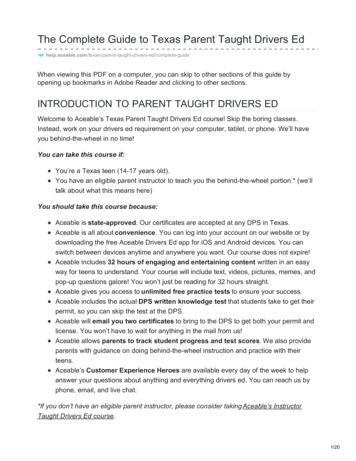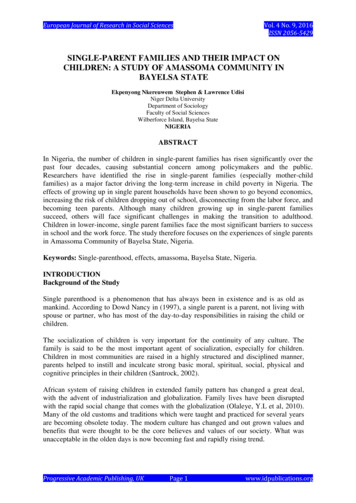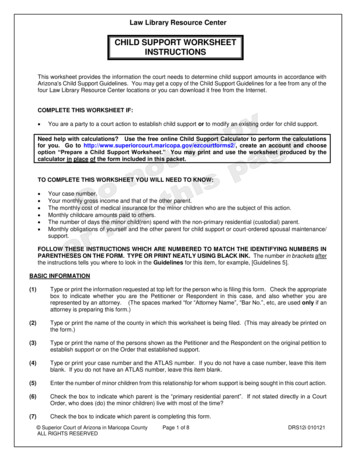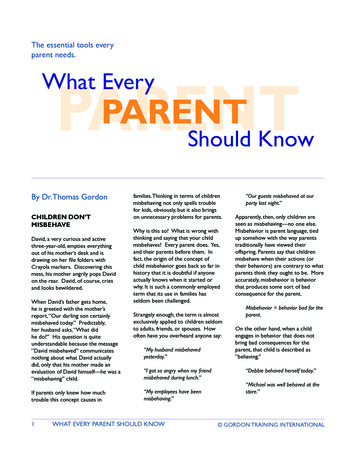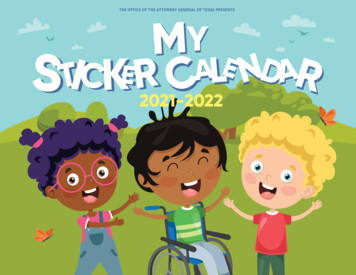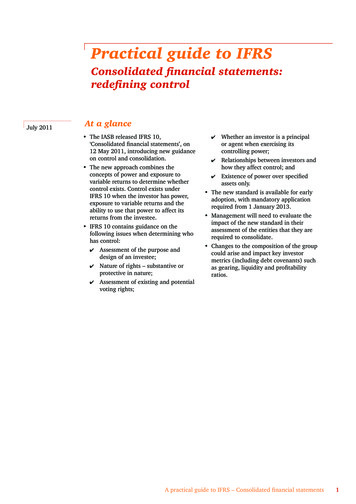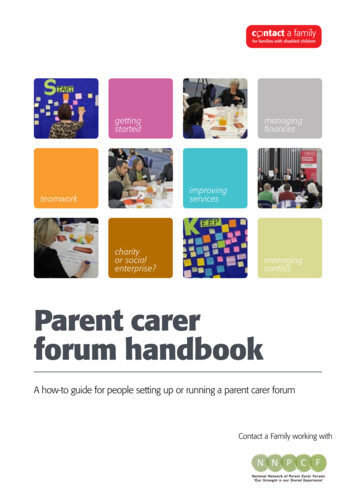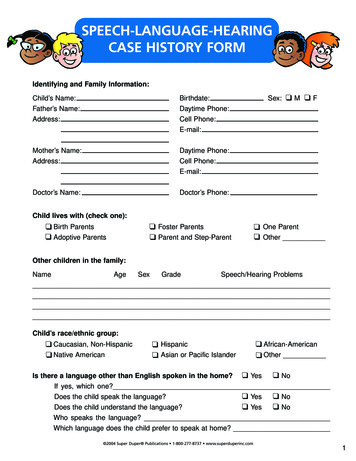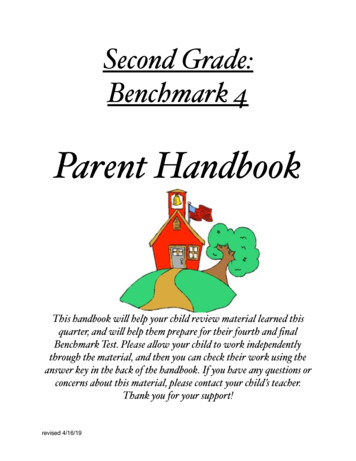
Transcription
Second Grade:Benchmark 4Parent HandbookThis handbook will help your child review material learned thisquarter, and will help them prepare for their fourth and finalBenchmark Test. Please allow your child to work independentlythrough the material, and then you can check their work using theanswer key in the back of the handbook. If you have any questions orconcerns about this material, please contact your child’s teacher.Thank you for your support!revised 4/16/19
Second Grade Essential Math StandardsLearning Objective # 1:2.M.OA.C.04 The Highly Proficient student can arrange objectsinto equal rows and columns, and write a multiplicationequation using the information created with the array.Practice:1. What is the total area of the shape below?a. 12 units2b. 10 units2c. 15 units2d. 20 units22. Explain why you think your answer is correct on the lines below:revised 4/16/19
3. What is the total area of the shape below?a. 12 units2b. 10 units2c. 15 units2d. 20 units24. Draw an array that matches the following number sentence.4 4 45. What number sentence matches this array?!a.b.c.d.2 2 26 6 6 64 4 45 5revised 4/16/19
Learning Objective # 2:2.M.OA.A.01 The Highly Proficient student can create a wordproblem and solve it by creating an equation; then explain thesteps used throughout the process.Practice:6. Which equation represents this word problem?Terri is having a party at her house. She started the party with 50 cans ofsoda. At the end of the party there were 17 cans left. How many canswere used during the party?a. 17 50b. 50 c. 50 - 17 17d. 50 17 7. Solve the following word problem.Mrs. Leach’s class collected 46 cans for the food drive. Mrs. West’s classcollected 32 more cans than Mrs. Leach’s class. How many cans did Mrs.West’s class collect?a. 14 cansb. 78 cansc. 67 cansd. 33 cansrevised 4/16/19
8. Solve the following word problem.There are 23 students in Mr. Smith’s class. Mr Smith asked the class what theirfavorite flavor of ice cream was. 7 responded with chocolate, 8 responded withstrawberry, and the remaining classmates responded with vanilla. How manystudents preferred vanilla?a.b.c.d.58979. 87 second graders are on a field trip to the pumpkin patch. The pumpkinpatch is 54 miles from the school. They have traveled 26 miles so far. How manymore miles do they have to go?Write an equation to represent the following problem. Use a symbol for theunknown number. Solve the problem. Learning Objective # 3:2.M.G.A.02 The Highly Proficient student can create four differentfigures with an area of 24 and recognize that multiplication can be usedto find area (area length x width).Practice:10. How many same sized squares are on this geoboard?revised 4/16/19
11. Partition the rectangle into three rows and threecolumns. How many same size squares do you have?a.6b.9c.12d.3revised 4/16/19
Learning Objective #42.M.MD.D.10 The Highly Proficient student can create a survey tocollect data, record, organize, and display the data using different types ofgraphs. They can also create word problems with solutions for each oftheir graphs. (Vail/BT expectation use tally charts and create and answerquestions)Practice:12. Which of the data tables below matches the bar graph?revised 4/16/19
13. Which bar graph represents the data below?2nd Grade’s Favorite Types of Ice Creamrevised 4/16/19
Benchmark 4 Essential Math Vocabularyarea - measures the inside space in square units.rows - an arrangement of figures, side by side in a horizontalline.columns - an arrangement of figures, one above the other.square unit - the unit used for measuring area.data- information gathered from an experiment or surveygraph- a diagram that represents data gathered from anexperiment or survey.tally marks- a way of keeping track of numbers in groups of 5.equation or number sentence - a mathematical statement usingan equal sign.word problem - also known as a story problem that requiresmath operations or equations to solve.array - an orderly arrangement, often in rows or columns.revised 4/16/19
Math Answer Key1. C2. Answers will vary.3. A4. !5. D6. C7. B8. B9. 54-26 X10. 1211. B12. C13. Crevised 4/16/19X 28
Second Grade Essential Reading StandardsLearning Objective # 1:2.R.RI.02 The Highly Proficient student can identify and summarize the main ideaand supporting details of each paragraph within a multi-paragraph text.Practice:Read the story below and answer the questions that follow:Cheetahs are large, spotted cats that live in Africa's grasslands. They are thefastest of all the land animals. Their speeds can top 70 miles per hour. Although they arefast, cheetahs can not maintain that speed for more than 100 yards at a time. The namecheetah comes from an Indian word meaning “spotted one”.1. What is the main idea of the passage above?a. The name cheetah means “spotted one.”b. Cheetahs are large cats that live in Africa.c. Cheetahs can run 70 miles per hour.d. Cheetahs are spotted.2. What did you learn from the passage?a. Cheetahs live in the United States.b. Cheetahs are not very fast animals.c. Cheetahs can run at top speed for many miles.d. Cheetahs are the fastest of all land animals.revised 4/16/19
Learning Objective # 2:2.R.RL.05 The Highly Proficient student can create their own literary tale usingthe basic structure of a story.Practice:Read the story below, then answer the questions that follow:Libby stood on a chair to watch her brother Max make cookies. He mixed sugarand butter. He added eggs and salt. He stirred in three cups of flour and three cups ofchocolate chips. Then he spooned batter onto the pan. Finally, he baked the cookies inthe oven for ten minutes. Libby and Max enjoyed their fresh baked cookies together!3. What did Max do after he added the butter?a.b.c.d.He added chocolate chips.He spooned batter into the pan.He added the flour.He added eggs.4. What is the first step Max did to make his cookies?a.b.c.d.He stood on a chair.He mixed sugar and butter.He spooned batter onto the pan.He added eggs and salt.5. In what part of the story did Libby stand on a chair?a. the endb. the beginningc. the middlerevised 4/16/19
Learning Objective # 3:2.R.RL.03 The Highly Proficient student can use a Venn Diagram to compare and contrast theresponse to major events or challenges of one character to the response of another character.The Closet Creatureby Kelly HashwayBump! Bump! Scratch!Adam opened his eyes and pulled the covers up to his chin. He stared around his room,searching the darkness for the thing that was making those scary sounds.The closet door moved as something banged on it from the inside.“Who’s there?” Adam asked in a shaky voice.The closet slowly began to open. Adam jumped out of bed and ran to the closet door,slamming it shut with his palms. He grabbed his desk chair and propped it against the doorhandle. Then he ran out of his room and down the hall. His brother’s door was wide open,and Adam jumped onto David’s bed.“Adam?” David asked in a groggy voice. “What are you doing in here?”Adam tugged on David’s arm. “There’s something in my closet!” “You probably had abad dream. Go back to bed.” Adam yanked the blankets off the bed. “It wasn’t a dream. Iwas awake, and the closet door started opening by itself!”David sighed. “Fine. But when we don’t find anything, you have to promise to leave me.Adam nodded. David reached into his desk drawer and pulled out a flashlight. Then theyheaded to Adam’s room. Adam stopped in the doorway. He could hear somethingscratching his closet door. “Do you hear that?” Adam asked.David nodded. He walked over to Adam’s bed and pulled the case off one of the pillows. Heopened the pillowcase. “You open the door very slowly, and I’ll grab whatever it is.”Adam slid the chair to the side and pulled the closet door open a crack. Somethingbanged against the door, trying to force it open. Adam took a deep breath and opened thedoor a few more inches. A small furry creature ran right into the pillowcase.“I got it!” David said, closing the pillowcase and holding it in the air.“What is it?” Adam moved closer as David peeked inside.revised 4/16/19
David put the pillowcase on the bed and an orange cat climbed out. Adam scooped thecat up. “Apricot? How did you get trapped in my closet?” David laughed. “The poor cat. If Iwas locked in your closet with your stinky shoes, I’d be banging on the door to get out, too!”“Poor, Apricot,” Adam said. “You were probably more scared than I was.”6.What was the major problem Adam was having in the story?a. Adam’s brother was sleeping.b. Adam had stinky shoes.c. Adam heard sounds coming from his closet and the door was moving.7.How does Adam first react to the problem?a. He jumps in his brother’s bed.b. He slams the closet door shut.c. Adam stands in the doorway of his room.8.What actions did Adam’s brother take in solving the problem?a. He took Adam’s pillowcase and used it to catch the creature.b. He told Adam it was a dream and to go back to bed.c. He nodded at Adam that he could hear the scratching noise.9.What word would best describe Adam’s feelings when he realized it was his pet catApricot?a.b.c.d.upsetscaredrelievedsad10. At the end of the story Adam says to Apricot “ You were probably more scaredthan I was”. How did Adam act that would suggest he was scared too?a. Adam stared around his room.b. Adam ran out of his room and down the hall.c. David grabbed a flashlight from his drawer.revised 4/16/19
Learning Objective # 4:2.R.RI.09 The Highly Proficient student can compare and contrast the same topicusing several different texts and summarize their findings in their own words usingevidence from their sources.Practice: Read the following passages about two types of reptiles. Use the Venndiagram on the following page to compare and contrast.AlligatorsThe are two types of alligators. The American alligator that can grow inlength to almost 12 feet and the Chinese alligator which can grow to almost5 feet. Alligators have a wide, rounded snout and are typically darker incolor than crocodiles. What is fascinating about both these reptiles is theyhave excellent hearing. The slits on their heads close up when they dive inthe water. When an alligator closes it’s mouth just the upper teeth are seen.You can find alligators spending their time mostly in freshwater areas suchas swamps, ponds and rivers. They do not have the salt-secreting glandsfound on crocodiles, but can tolerate low levels of saltwater for a shortperiod of time. Alligators living in the wild are only found in the UnitedStates and China. In 1987, Florida officially declared the alligator as theirstate reptile.CrocodilesIf you are wondering where crocodiles lives you will find them in manyplaces around the world such as Africa, Asia, Australia and America.There are thirteen species of crocodiles. One unique feature about thecrocodile is they have salt glands on their tongues which allows them tolive in saltwater habitats. Crocodiles have a longer more V shaped jaw.The fourth tooth on each side of their lower jaw can been seen even whenthey close their mouths. Like alligators, crocodiles are carnivores and eatwhatever they can catch in the water or nearby. These tough skinnedreptiles tend to be lighter in color for crocodiles. The word’s mostendangered species of crocodiles is the Cuban crocodile.Resources used: http://www.livescience.com/28306-crocodiles.html, crocodilealligatordifferences.htmlrevised 4/16/19
11.AlligatorsSameCrocodiles1.1.1.2.2.2.12. Which of the following statements is true?a. Alligators can tolerate saltwater for long periods of time.b. Both alligators and crocodiles have salt glands located on theirtongues.c. Only crocodiles have salt glands which allow them to live in saltwaterhabitats.13. Which of the following statements represents something similar foralligators and crocodiles?a. Both alligators and crocodiles live only in the United States andChina.b. These reptiles have excellent hearing.c. Both alligators and crocodiles are the official state reptile for Florida.revised 4/16/19
Benchmark 4 Essential Reading Vocabularystory structure: how a story is put together. It is made up ofthe beginning, middle and end.characters: the people, animals, or things in a storyplot: the events in a storysetting: where a story takes placemain idea: what a story or passage is mostly aboutdetails: statements that support the main ideafacts: are true statements that can be proved or found in thestory or textsequencing: putting the events of a story in ordercompare and contrast: find similarities anddifferencesstory event: something important that happens in astorychallenge: a difficult task or problemrevised 4/16/19
Reading Answer Key1. B2. D3. D4. B5. B6. C7. B8. A9. C10. B11. Alligators: 2 types, wide rounded snout, darker in color,Florida’s state reptile, found only in US and ChinaCrocodiles: 13 species, salt glands, longer more V shaped jaw,can be found in many places around the world, 4thtooth can be seen.Same: carnivores, tough skin, reptiles, excellent hearing12. B13. Brevised 4/16/19
The Closet Creature by Kelly Hashway Bump! Bump! Scratch! Adam opened his eyes and pulled the covers up to his chin. He stared around his room, searching the darkness for the thing that was making those scary sounds. The closet
